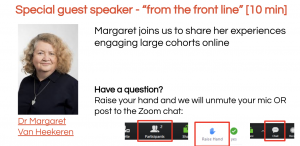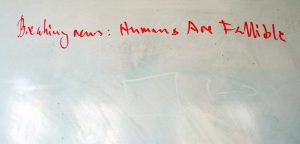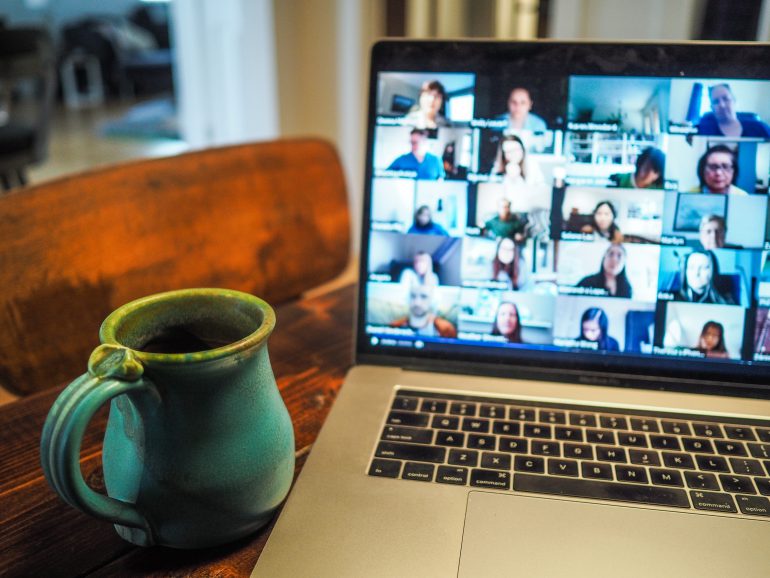Centred on the FASS (Faculty of Arts and Social Sciences) pedagogical values, On by Our Design (OBOD) provides a platform for teaching and education support staff to access and engage in shared teaching and learning resources.
In this article, I sit down with Dr Margaret Van Heekeren to discuss excellence in teaching, what makes a great lecture, and how remote teaching changed our teaching identities. Margaret is a media and journalism historian who worked as a journalist for fifteen years and has taught Media and Communications for over seventeen years. Margaret was the sole recipient of the FASS Excellence in Teaching with Distinction in 2021.
Leanne Stevenson: Teaching is a reflective practice and as a practice, we’re always learning and we’re always hopefully improving as well, whereas excellence implies the highest standard, that you’ve reached the top. What does excellence mean within teaching as a practice?
Margaret Van Heekeren: Reaching the top, really to do that, is unachievable. But that’s the goal that I’m always striving for. My teaching philosophy is very student-centred. That’s the way I approach learning and teaching, so whether you have 10 students or hundreds of students I teach them all as if they were one student and try to respond to each student as a person, rather than as a member of a cohort. And in order to do that, it means being mindful of the student’s place in the unit, where they come from – if it’s a first-year unit and they’re transitioning to university, their academic position, but also, their social position, other external pressures, and over the last couple of years, COVID.
I use some of the time in class to get feedback and check with students ‘What are you finding hard about COVID?’ or after an assessment or during assessment, ‘what is it about this, how are finding the timing of the assessment with others, what’s particularly challenging, what do you feel hasn’t prepared you enough for this assessment’?. So, I do a lot more ad hoc conversational chat and try to stay in touch as much as possible. I give student emails as much priority as I give anybody in the university. I always respond quickly and in all my units I set up a range of forms of communication. During remote teaching, I set up some extra drop-in sessions over Zoom for Q&A over the final assignment.
It’s really being there for them as if they’re your only student, regardless of how many there are.
Leanne: In your award application you sought to demonstrate excellence, not according to your own measure, but what students and colleagues assess as excellence. How important is a learning and teaching community to your practice?
Margaret: Highly important, from the department right through the university, there is an incredible amount of support at Sydney University. And not just support, collaboration, so many opportunities for collaboration, probably far too many then there’s time. At a local level within the department, it is lots of corridor chats about what’s working what’s not working and bouncing ideas off others – that’s really critical. Then within the faculty, it’s the exposure you get through things like Online by Our Design.
To see what other people are doing, although their disciplines may be very different, allows you to make parallels with your own teaching.
I did the Graduate Certificate (Higher Education) last year, which was fantastic, but even as a casual I was taking up opportunities, such as Open Door sessions, which are a great way to expose you to other teaching practices and I really try to go outside my own discipline and see what is happening.
My favourite memory is going to a chemistry open door, and chemistry is probably one of the farthest removed things from media. The whole lecture was just beyond me, it’s very different from the way science is taught, but during the breaks, the lecturer played music from his own Spotify, and you could just see how the students really responded to it.
I took that into the break during my two-hour lecture for a first-year unit and adapted it a little bit; I chose songs that had media themes, like Radio Gaga by Queen. And then I came up with the idea to share a spreadsheet and got the students to suggest media related songs, and in the USS students started commenting how it was great they could choose the songs. It switched that power imbalance by just giving them more agency in an insignificant and almost irrelevant part of the unit, but it helps create that overall atmosphere.
It’s always the little things, of course, that add up.
Leanne: What is the difference between a great tutor and a great lecturer? Do you think of those roles as requiring different skills?

Margaret: I don’t see much difference at all, and I see them all as a performance because none of them are naturally me. I’m not a person who loves to jump up in front of 500 people or even 20 people and try to engage them. I see it as a performance and whether you’re lecturing or tutoring and whether you’re doing it on zoom, which makes it much harder, you’re constantly watching the audience for student feedback to see how you’re going and you’re measuring it, you know, and then by getting questions and prompting for that feedback. Tutoring is just a smaller audience. I’m a guest speaker in the MPLF (Modular Professional Learning Framework) module “engaging students in lectures and large classes” and when I make that point about how it’s performance in a lecture there are always some comments in chat from people who are a little bit sceptical, who think ‘well, no, this is teaching, you know it shouldn’t be entertainment’. I would argue, this isn’t entertainment for entertainment’s sake, but you need to be engaging. If you don’t engage them then they’re not going to learn, although you’ve got a different outcome from the actor in theatre, which is to entertain. Our outcome is for students to learn, but behind that, if the audience or students aren’t engaged then neither is going to happen, they’re not going to be entertained in a theatre and they’re not going to learn in the lecture.
I’ve really adapted my lecturing style to be more facilitative as well. I run very interactive lectures with a lot of Q&A, exercises, polls, you name it.
I love Padlet because it gives students the ability to post anonymously. And Mentimeter is really cool, for creating word clouds in lectures. I’ll ask ‘what are your thoughts about this, in one word’… and then it all comes up as a word cloud, and you get to see what is most dominant in the student’s minds which it’s a great way of getting your head to where their head is, and it can be quite surprising sometimes. I just love Piazza as a space for students to ask questions about assignments, rather than having them email me, and I encourage them to put it on Piazza because then other students will see the question. I bring students in as much as possible, and I see that as facilitating their learning, just as you do in a tutorial.
Leanne: Something that I think we have difficulty talking openly about as teachers is how the pandemic is really affecting students. How important is having empathy for students?
Margaret: Important is an understatement, it was absolutely crucial. I realised early on that these kids are really affected, particularly as I was teaching first-year. That huge transition of life, going from school, they’ve been building to this point for years and dreaming about it. And then, suddenly, they were here for three weeks, and then that was robbed. Personally, I felt gutted for them, as many of them did. Recognising that was huge. What helped to be empathetic rather than just sympathetic was that I’ve never experienced a pandemic before either, none of us has. We were all in the same situation; that huge uncertainty initially was overwhelming. From the start, I was really open with the students about that, ‘hey I haven’t done this before either, I’m here with you’.
I remember that first semester of COVID and the two-hour lecture I ran finished at six o’clock on a Monday night, and I never would have talked about my dinner when I was leaving my face-to-face lectures in Wallace Theatre at six o’clock at night, but now I saw them off for dinner each week.
Empathy helps to build that sense of community that’s not just about the unit, or studying…
…if you can develop personal connections with the students, through just human connection, then I think that opens the students to be receptive to the learning that you’re delivering as well.

Previously, we wanted to show that we were infallible. If you were turning up at a lecture with a stomach bug or something you didn’t let students know that, but once we went online, things shifted. I remember five minutes before my first lecture was due to start, I lost all the electricity in my house! I had nothing, and I’m trying to get on Zoom with my phone! There has been a couple of situations like that, where you’re obviously so fallible you can’t hide it anymore, and the students like that. I didn’t realise that until Zoom and online teaching. When I went back to teaching on campus this year in first semester, I took that fallibility back with me because it really furthers that human connection with the students.
I’m trying to perform excellence, but I’ve learned that fallibility doesn’t hurt.
Want to know more?
- Enrol in Modular Professional Learning Framework – to see Margaret in action, check out module 8!
- See how to use edtech such as Padlet, Mentimeter, or Socrative to introduce interactivity, connection, and much more, depending on your teaching needs.
- Check out the University’s Open Door program (returning Semester 1, 2022) – information will be posted on the Educational Innovation events page soon!





